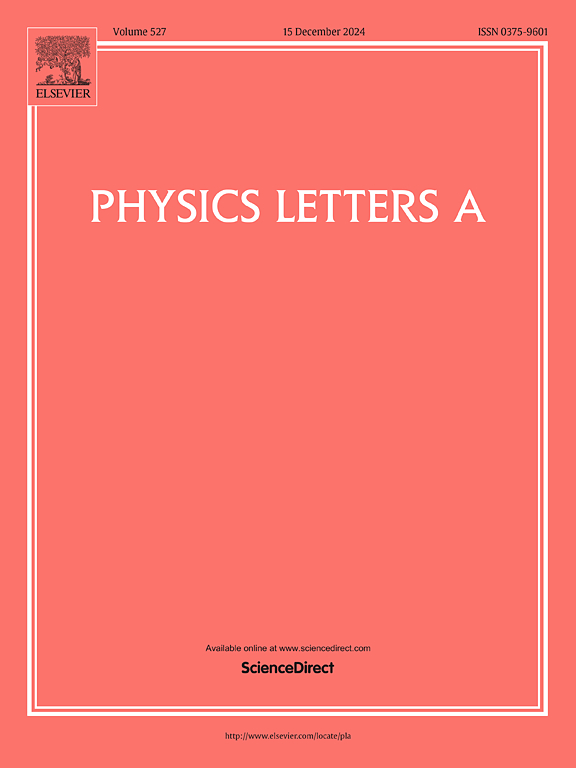Electronic and nonlinear optical properties of dielectric-encapsulated concentric quantum nano-rings for tunneling devices in microelectronics under axial electric field
IF 2.3
3区 物理与天体物理
Q2 PHYSICS, MULTIDISCIPLINARY
引用次数: 0
Abstract
Addressing critical challenges in quantum device engineering and tunneling phenomena, this meticulous study theoretically scrutinizes the optical absorption coefficients (OACs) as well as the refractive index changes (RICs) resulting from intersubband transitions in a concentrically coupled nano-quantum ring (CCNQR). We mainly focus on the impact of in-situ structural parameters (inner radius, height, inner and outer ring widths), electric field, incident optical intensities and the choice of oxidized dielectric environment (SiO2 vs. HfO2). Under the framework of the effective mass approximation and the compact density matrix approach, the subband energy eigenvalues and their associated wavefunctions were determined by solving the time-independent Schrödinger equation. Contrary to other studies reported in the literature, we took into account the conduction band discontinuity that originates at the system and its surrounding medium, as well as the dielectric mismatch. Our findings demonstrated a strong correlation between quantized energies, dipole moments and the key structural metrics as well as the applied external electric field. Incorporating the electric field and surrounding oxides into our calculations resulted in a significant alteration of the probability amplitude and spatial distribution of the wavefunction by exhibiting two distinct regimes: coupled and decoupled. Our major outcomes revealed that when F = 30 KV/cm, the dipole moment is 1.42 times larger when choosing the HfO2. We found that the OAC’s resonant peak has reached 7,2 × 105 m-1 (8.6 × 105 m-1) in case of SiO2 (HfO2). In addition, for HfO2 (SiO2), the photobleaching phenomenon was observed at an intensity of I = 0.2 MW/cm2 (I = 0.4 MW/cm2). We conclude that the resonance frequencies as well as the intensity of the nonlinear optical attributes are roughly tunable through geometric factors and the electric field, while fine-tuning could be achieved through a careful choice of the surrounding oxidative layer.
轴向电场作用下微电子隧道器件用介质封装同心量子纳米环的电子学和非线性光学特性
为了解决量子器件工程和隧道现象中的关键挑战,本研究从理论上仔细研究了同心耦合纳米量子环(CCNQR)中由子带间跃迁引起的光吸收系数(OACs)和折射率变化(RICs)。我们主要关注原位结构参数(内半径、高度、内外环宽度)、电场、入射光强和氧化介质环境选择(SiO2 vs. HfO2)的影响。在有效质量近似和紧凑密度矩阵方法的框架下,通过求解与时间无关的Schrödinger方程确定子带能量特征值及其相关波函数。与文献中报道的其他研究相反,我们考虑了起源于系统及其周围介质的导带不连续以及介电失配。我们的发现证明了量子化能量、偶极矩与关键结构指标以及外加电场之间有很强的相关性。将电场和周围的氧化物纳入我们的计算中,通过显示两种不同的状态:耦合和去耦,导致波函数的概率振幅和空间分布发生了重大变化。我们的主要结果表明,当F = 30 KV/cm时,选择HfO2时的偶极矩增加了1.42倍。我们发现SiO2 (HfO2)的OAC共振峰达到了7.2 × 105 m-1 (8.6 × 105 m-1)。此外,对于HfO2 (SiO2),在I = 0.2 MW/cm2 (I = 0.4 MW/cm2)的强度下观察到光漂白现象。我们得出结论,共振频率和非线性光学属性的强度可以通过几何因子和电场进行大致调整,而通过仔细选择周围的氧化层可以实现微调。
本文章由计算机程序翻译,如有差异,请以英文原文为准。
求助全文
约1分钟内获得全文
求助全文
来源期刊

Physics Letters A
物理-物理:综合
CiteScore
5.10
自引率
3.80%
发文量
493
审稿时长
30 days
期刊介绍:
Physics Letters A offers an exciting publication outlet for novel and frontier physics. It encourages the submission of new research on: condensed matter physics, theoretical physics, nonlinear science, statistical physics, mathematical and computational physics, general and cross-disciplinary physics (including foundations), atomic, molecular and cluster physics, plasma and fluid physics, optical physics, biological physics and nanoscience. No articles on High Energy and Nuclear Physics are published in Physics Letters A. The journal''s high standard and wide dissemination ensures a broad readership amongst the physics community. Rapid publication times and flexible length restrictions give Physics Letters A the edge over other journals in the field.
 求助内容:
求助内容: 应助结果提醒方式:
应助结果提醒方式:


